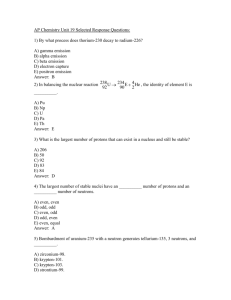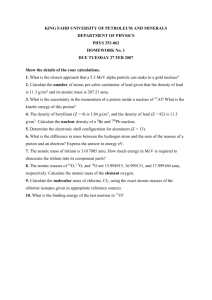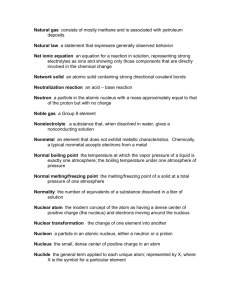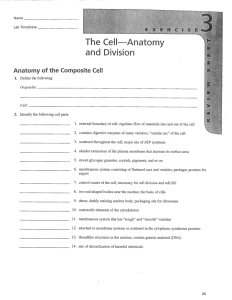AP Chemistry Unit 1 Selected Response Questions
advertisement
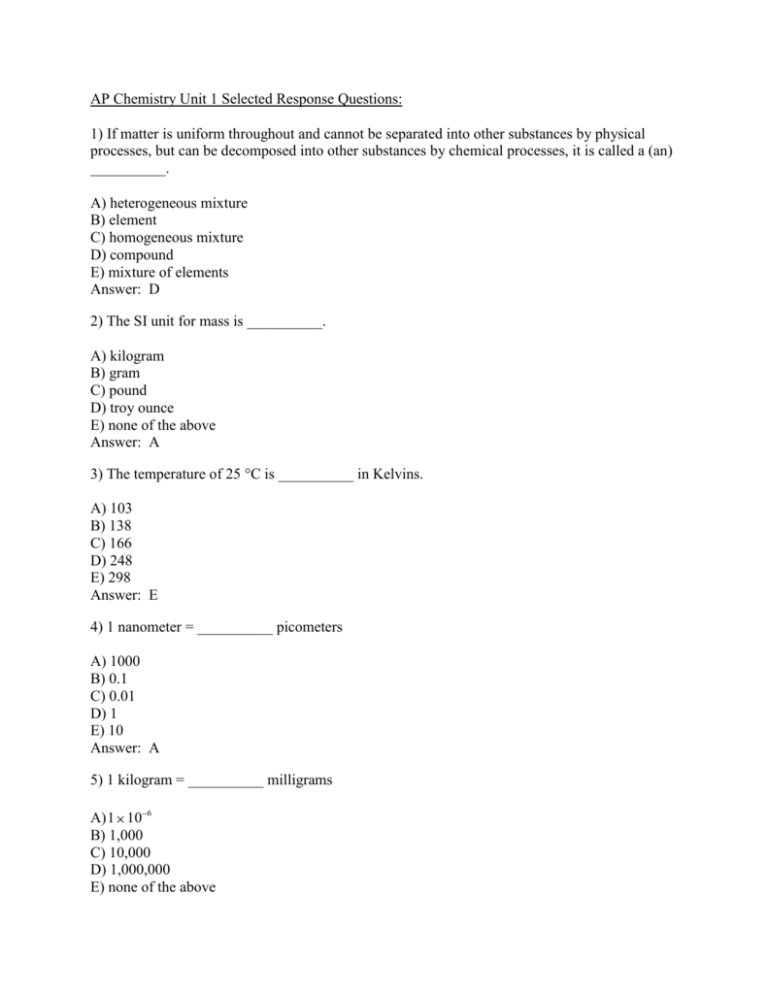
AP Chemistry Unit 1 Selected Response Questions: 1) If matter is uniform throughout and cannot be separated into other substances by physical processes, but can be decomposed into other substances by chemical processes, it is called a (an) __________. A) heterogeneous mixture B) element C) homogeneous mixture D) compound E) mixture of elements Answer: D 2) The SI unit for mass is __________. A) kilogram B) gram C) pound D) troy ounce E) none of the above Answer: A 3) The temperature of 25 °C is __________ in Kelvins. A) 103 B) 138 C) 166 D) 248 E) 298 Answer: E 4) 1 nanometer = __________ picometers A) 1000 B) 0.1 C) 0.01 D) 1 E) 10 Answer: A 5) 1 kilogram = __________ milligrams A) 1 10 6 B) 1,000 C) 10,000 D) 1,000,000 E) none of the above Answer: D 6) The density of silver is 10.5 g/cm3 . A piece of silver with a mass of 61.3 g would occupy a volume of __________ cm 3 . A) 0.171 B) 644 C) 10.5 D) 0.00155 E) 5.84 Answer: E 7) 3.337 g/cm3 = __________ kg/m 3 A) 3.337 10 9 B) 3.337 10 5 C) 3337 D) 0.3337 E) 333.7 Answer: C 8) The number 1.00430 has __________ significant figures. A) 2 B) 3 C) 5 D) 6 E) 4 Answer: D 9) The correct answer (reported to the proper number of significant figures) to the following is __________. 6.3 × 3.25 = __________ A) 20. B) 20.475 C) 20.48 D) 20.5 E) 21 Answer: A 10) The correct result of the molecular mass calculation for H 2SO4 is _____________. 4 × 15.9994 + 32.066 + 2 × 1.0079 = A) 98.08 B) 98.079 C) 98.074 D) 98.838 E) 98.84 Answer: B Constructed response and performance event questions: 1) Gases do not have a fixed __________ as they are able to be __________. Answer: volume, compressed 2) Mass and volume are often referred to as __________ properties of substances. Answer: extensive 3) 1.035 10 4 L = __________ mL Answer: 0.1035 4) The correct answer (reported to the proper number of significant figures) to the following is __________. 11.5 × 8.78 = __________ Answer: 101 5) What is the name given to the unit that equals (a) 10-9 gram, (b) 10-6 second, (c) 10-3 meter? Answer: The prefix related to each of the decimal fractions: (a) nanogram, ng, (b) microsecond, s, (c) millimeter, mm. 6) What difference exists between the measured values 4.0 g and 4.00 g? Answer: The value 4.0 has two significant figures, while 4.00 has three. This difference implies that the first measurement has more uncertainty 7) The width, length, and height of a small box are 15.5 cm, 27.3 cm, and 5.4 cm, respectively. Calculate the volume of the box, using the correct number of significant figures in your answer. Answer: 2.3 x 10-3 cm3 8) A gas at 25 °C fills a container whose volume is 1.05 103 cm3. The container plus gas have a mass of 837.6 g. The container, when emptied of all gas, has a mass of 836.2 g. What is the density of the gas at 25 °C? Answer: 0.0013 gm/cm3 9) The average speed of a nitrogen molecule in air at 25 °C is 515 m/s. Convert this speed to miles per hour. Answer: 1.15 x 103 mi/hr 10) Earth’s oceans contain approximately 1.36 liters. Answer: 1.36 x 1021 L 109 km3 of water. Calculate the volume in AP Chemistry Unit 19 Selected Response Questions: 1) By what process does thorium-230 decay to radium-226? A) gamma emission B) alpha emission C) beta emission D) electron capture E) positron emission Answer: B 2) In balancing the nuclear reaction 238 U 92 __________. 234 E 4 He , the identity of element E is 90 2 A) Pu B) Np C) U D) Pa E) Th Answer: E 3) What is the largest number of protons that can exist in a nucleus and still be stable? A) 206 B) 50 C) 92 D) 83 E) 84 Answer: D 4) The largest number of stable nuclei have an __________ number of protons and an __________ number of neutrons. A) even, even B) odd, odd C) even, odd D) odd, even E) even, equal Answer: A 5) Bombardment of uranium-235 with a neutron generates tellurium-135, 3 neutrons, and __________. A) zirconium-98. B) krypton-101. C) krypton-103. D) strontium-99. E) zirconium-99. Answer: A 6) How many neutrons are emitted when a californium-249 nucleus (Z=98) is bombarded with a carbon-12 nucleus to produce a 257 Rf nucleus ? 104 A) one B) three C) two D) four E) zero Answer: D 7) 131I has a half-life of 8.04 days. Assuming you start with a 1.53 mg sample of 131I, how many mg will remain after 13.0 days? A) 0.835 B) 0.268 C) 0.422 D) 0.440 E) 0.499 Answer: E 8) What order process is radioactive decay? A) zeroth B) first C) second D) third E) fourth Answer: B 9) On average, __________ neutrons are produced by every fission of a uranium-235 nucleus. A) 4 B) 3.5 C) 1 D) 2.4 E) 2 Answer: D 10) The mass of a proton is 1.00728 amu and that of a neutron is 1.00867 amu. What is the mass defect (in amu) of a 60 Co nucleus? (The mass of a cobalt-60 nucleus is 59.9338 amu.) 27 A) 27.7830 B) 0.5489 C) 0.5405 D) 0.0662 E) 0.4827 Answer: B Constructed response and performance event questions: 1) What happens in the nucleus of an atom that undergoes positron emission? Answer: A proton is converted to a neutron and a positron. 2) What happens to the atomic mass number and the atomic number of a radioisotope when it undergoes alpha emission? Answer: The mass number drops by 4 and the atomic number decreases by 2. 3) What isotope of what element is produced if krypton-81 undergoes beta decay? Answer: rubidium-81 4) The first nuclear transmutation resulted in the conversion of nitrogen-14 to __________. Answer: oxygen-17 5) The half-life for the beta decay of potassium-40 is 1.3 109 years . What is the rate constant for this decay? Answer: t1 2 0.693/ k 1.3 109 years 0.693/ k k 5.3 10 10 year 1 6) Electrons do not exist in the nucleus, yet beta emission is ejection of electrons from the nucleus. How does this happen? Answer: A neutron breaks apart to produce a proton and an electron in the nucleus. The proton remains in the nucleus and the electron is ejected. 7) List the common particles and their symbols used in descriptions of radioactive decay and nuclear transformations. Answer: 8) When an isotope undergoes electron capture, what happens to the captured electron? Answer: It combines with a proton in the nucleus to form a neutron. 9) The use of radioisotopes in tracing metabolism is possible because __________. Answer: all isotopes of an element have identical chemical properties 10) The amount of fissionable material necessary to maintain a chain reactions is called the __________. Answer: critical mass AP Chemistry Unit 20 Selected Response Questions: 1) The simplest alkyne is __________. A) ethylene B) ethane C) acetylene D) propyne E) benzene Answer: C 2) The melting and boiling points of hydrocarbons are determined by __________. A) ion-dipole attraction B) dipole-dipole attraction C) London forces D) hydrogen bonding E) ionic bonding Answer: C 3) The molecular geometry of each carbon atom in an alkane is __________. A) octahedral B) square planar C) trigonal planar D) tetrahedral E) trigonal pyramidal Answer: D 4) The general formula of an alkane is __________. A) C H 2n 2n 2 B) C H n 2n C) C H n 2n 2 D) C H n 2n - 2 E) C H n n Answer: C 5) What is the name of the compound below? A) 2,4-methylbutene B) 2,5-dimethylpentane C) 2,4-ethylbutene D) 2,4-dimethyl-1-pentene E) 2,4-dimethyl-4-pentene Answer: D 6) The name of CH3 -CH=C=CH-CH-CH=CH-CH3 is __________. A) 2, 3, 5 - octatriene B) 2, 5, 6 - octatriene C) 2, 3, 6 - octatriene D) 3, 5, 6 - octatriene E) 3, 4, 7 - octatriene Answer: C 7) The addition of HBr to 2-butene produces __________. A) 1-bromobutane B) 2-bromobutane C) 1,2-dibromobutane D) 2,3-dibromobutane E) no reaction Answer: B 8) The general formula for an ether is __________. A) B) C) D) E) Answer: A 9) The general formula of a carboxylic acid is __________. A) B) C) D) E) Answer: C 10) Which structure below represents a ketone? A) B) C) D) E) Answer: D Constructed response and performance event questions: 1) Why is cyclopropane more reactive than propane? Answer: the small ring of cyclopropane forces the C-C-C bond angle to be significantly less than 109.5 ° of __________ the tetrahedral structure of C in propane. 2) Write the formula for 2-methyl-4-propylnonane. Answer: 3) What is the correct name for the compound, CH 3 CH 2 CH CHCH 2 CH CHCH 3 ? Answer: 2,5-octadiene 4) What is the name of the compound below? Answer: 4,6-dimethyl-1-heptyne 5) Predict the product of the catalytic hydrogenation of 6-ethyl-3-decene. Answer: 6-ethyldecane 6) What is the name of the compound below? Answer: 4-propyloctane 7) The formation of aspirin by reacting salicylic acid with acetic acid is a __________ reaction. Answer: condensation 8) In the oxidation of ethanol the intermediate formed is __________. Answer: acetaldehyde 9) The aromas of different fruit are due to the chemical compounds known as __________. Answer: esters 10) Non-superimposable mirror-image isomers of a substance are called __________. Answer: enantiomers AP Chemistry Labs All of the experiments below will require hands-on work in the laboratory. You will need to be able to repeat experiments for the laboratory practical. Chapter 1 2 3 4 4 5 7 10 10 10 11 13 13 14 14 15 16 16 17 17 17 17 20 25 Experiment (each experiment averages 60 – 90 minutes per week) Basic Lab Technique experiment Empirical Formula of an Oxide Lab Mole Relationship in a Chemical reaction Determination of Concentration of Vinegar by titration Standardization of NaOH Specific Heat, Heat of Reaction, and Hess’s Law Lab Spectrophotometry Lab Molecular Weight by Freezing Point Depression Determining the Molar Volume of a Gas Molar Mass of a Volatile liquid Liquid Chromatography Percentage of Water in a Hydrate Gravimetric Analysis of a Metal Carbonate Rates of Reaction: Iodination of Acetone Activity Series Spectrophotometric Determination of an Equilibrium Constant Determination of Ka of Weak Acids Selecting Indicators for Acid-Base Titrations Qualitative Analysis of Cations and Anions Oxidation – Reduction Titrations Synthesis of a Coordination Compound containing Iron Preparation and Properties of Buffer Solutions Electrochemical Cells Synthesis, Isolation, and Purification of an Ester Pacing Guide for AP Chemistry ** Based on a 128 hour year 1ST QUARTER Unit 1: Matter & Measurement Unit 2: Atoms, Molecules, & Ions 4 hours Unit 3: Stoichiometry NOTE: These units should be a review of topics covered in detail during the pre-AP chemistry course. Students could be provided with an independent study project over the summer months prior to the AP course to expedite the review of this material. Unit 4: Aqueous Reactions & Solution Stoichiometry 8 hours Unit 5: Thermochemistry 8 hours Unit 6: Electronic Structure of Atoms 7 hours Unit 7: Periodic Properties of the Elements 5 hours 32 hours 2ND QUARTER Unit 8: Chemical Bonding 6 hours Unit 9: Molecular Geometry & VSEPR Theory 8 hours Unit 10: Gases 6 hours Unit 11: Intermolecular Forces, Liquids, & Solids 5 hours Unit 12: Properties of Solutions 7 hours 32 hours 3RD QUARTER Unit 13: Chemical Kinetics 7 hours Unit 14: Chemical Equilibrium 10 hours Unit 15: Acid – Base Equilibrium 8 hours Unit 16: Titrations & Buffers 7 hours 32 hours 4TH QUARTER Unit 17: Chemical Thermodynamics Unit 18: Electrochemistry 8 hours 8 hours Unit 19: Nuclear Chemistry Unit 20: Organic & Biochemistry Review for AP Exam 5 hours 5 hours 6 hours 32 hours AP Chemistry Labs All of the experiments below will require hands-on work in the laboratory. You will need to be able to repeat experiments for the laboratory practical. Chapter 1 2 3 4 4 5 7 10 10 10 11 13 13 14 14 15 16 16 17 17 17 17 20 25 Experiment (each experiment averages 60 – 90 minutes per week) Basic Lab Technique experiment Empirical Formula of an Oxide Lab Mole Relationship in a Chemical reaction Determination of Concentration of Vinegar by titration Standardization of NaOH Specific Heat, Heat of Reaction, and Hess’s Law Lab Spectrophotometry Lab Molecular Weight by Freezing Point Depression Determining the Molar Volume of a Gas Molar Mass of a Volatile liquid Liquid Chromatography Percentage of Water in a Hydrate Gravimetric Analysis of a Metal Carbonate Rates of Reaction: Iodination of Acetone Activity Series Spectrophotometric Determination of an Equilibrium Constant Determination of Ka of Weak Acids Selecting Indicators for Acid-Base Titrations Qualitative Analysis of Cations and Anions Oxidation – Reduction Titrations Synthesis of a Coordination Compound containing Iron Preparation and Properties of Buffer Solutions Electrochemical Cells Synthesis, Isolation, and Purification of an Ester
